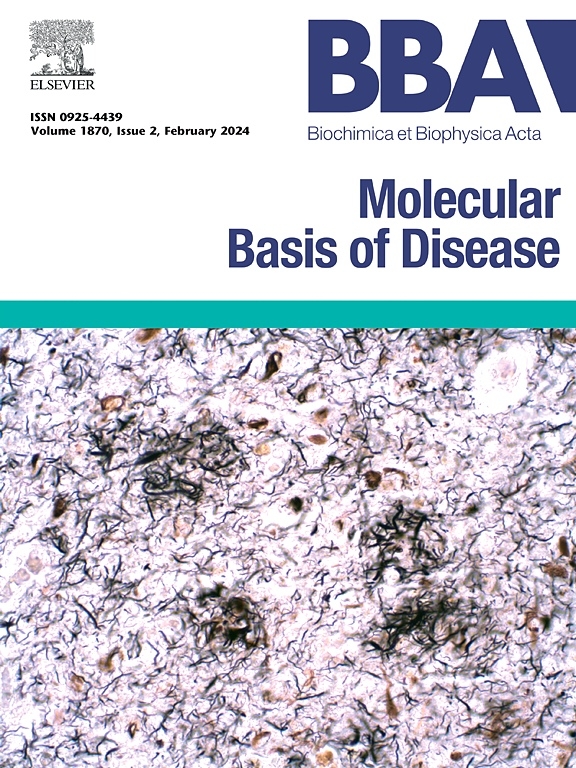Suppression of PCK1 attenuates neuronal injury and improves post-resuscitation outcomes
IF 4.2
2区 生物学
Q2 BIOCHEMISTRY & MOLECULAR BIOLOGY
Biochimica et biophysica acta. Molecular basis of disease
Pub Date : 2025-01-16
DOI:10.1016/j.bbadis.2025.167674
引用次数: 0
Abstract
Cardiac arrest (CA) is a critical medical emergency that can occur in both patients with preexisting conditions and otherwise healthy individuals. Despite successful resuscitation through cardiopulmonary resuscitation (CPR), many survivors are at significant risk of developing post-cardiac arrest syndrome (PCAS), a complex systemic response to CA that includes brain injury as a major component. Phosphoenolpyruvate carboxykinase 1 (PCK1), the first rate-limiting enzyme in gluconeogenesis, has been implicated in various diseases. However, its role in neuronal damage following CA/CPR remains unclear.
To investigate the role of PCK1 in neuronal damage after CA/CPR, we established the CA/CPR animal model and hypoxia/re‑oxygenation (H/R) cell model, manipulated PCK1 expression both in vivo and in vitro. We found increased expression of PCK1 in cortical neurons after CA/CPR. In vivo PCK1 overexpression exacerbated brain injury after CA/CPR via augmenting neuroinflammation and neuronal apoptosis. RNA-sequencing suggested PCK1-OE disturbed the neuronal metabolism while immunoprecipitation/mass spectrometry (IP/MS) revealed that PCK1 contributed to the mitochondrial dysfunction via binding to Voltage-dependent anion-selective channel 1 (VDAC1) and promoting its oligomerization and cytochrome c release. Besides, we confirmed that 3-Mercaptopicolinic acid (3-MPA), the PCK1 inhibitor, could ameliorate the mitochondrial dysfunction and apoptosis of neurons both in vitro and in vivo.
For the first time, we identified the detrimental role of PCK1 in post-CA brain injury. During CA/CPR, excessive PCK1 binds to VDAC1, promoting its oligomerization and cytochrome c release which leading to neuronal apoptosis and eventually PCAS. Utilization of 3-MPA during CPR could effectively improve the survival rate and prognosis of mice after CA, which may provide a novel strategy for CA/CPR treatment.

抑制PCK1可减轻神经元损伤并改善复苏后的预后。
心脏骤停(CA)是一种严重的医疗紧急情况,既可能发生在已有疾病的患者身上,也可能发生在其他健康个体身上。尽管通过心肺复苏(CPR)成功复苏,但许多幸存者仍有发生心脏骤停后综合征(PCAS)的重大风险,这是一种复杂的全身反应,包括脑损伤是CA的主要组成部分。磷酸烯醇丙酮酸羧激酶1 (Phosphoenolpyruvate carboxykinase 1, PCK1)是糖异生中的第一个限速酶,与多种疾病有关。然而,其在CA/CPR后神经元损伤中的作用尚不清楚。为了研究PCK1在CA/CPR后神经元损伤中的作用,我们建立了CA/CPR动物模型和缺氧/再氧化(H/R)细胞模型,在体内和体外操纵PCK1的表达。我们发现CA/CPR后皮质神经元中PCK1的表达增加。体内PCK1过表达通过增加神经炎症和神经元凋亡加重CA/CPR后脑损伤。rna测序表明PCK1- oe干扰了神经元代谢,免疫沉淀/质谱(IP/MS)显示PCK1通过结合电压依赖性阴离子选择通道1 (VDAC1)并促进其寡聚化和细胞色素c的释放而导致线粒体功能障碍。此外,我们在体外和体内均证实了PCK1抑制剂3-Mercaptopicolinic acid (3-MPA)可以改善线粒体功能障碍和神经元凋亡。我们首次发现PCK1在ca后脑损伤中的有害作用。在CA/CPR过程中,过量的PCK1与VDAC1结合,促进其寡聚化和细胞色素c的释放,导致神经元凋亡,最终导致PCAS。在心肺复苏术中使用3-MPA可有效提高CA后小鼠的存活率和预后,可能为CA/CPR治疗提供一种新的策略。
本文章由计算机程序翻译,如有差异,请以英文原文为准。
求助全文
约1分钟内获得全文
求助全文
来源期刊
CiteScore
12.30
自引率
0.00%
发文量
218
审稿时长
32 days
期刊介绍:
BBA Molecular Basis of Disease addresses the biochemistry and molecular genetics of disease processes and models of human disease. This journal covers aspects of aging, cancer, metabolic-, neurological-, and immunological-based disease. Manuscripts focused on using animal models to elucidate biochemical and mechanistic insight in each of these conditions, are particularly encouraged. Manuscripts should emphasize the underlying mechanisms of disease pathways and provide novel contributions to the understanding and/or treatment of these disorders. Highly descriptive and method development submissions may be declined without full review. The submission of uninvited reviews to BBA - Molecular Basis of Disease is strongly discouraged, and any such uninvited review should be accompanied by a coverletter outlining the compelling reasons why the review should be considered.

 求助内容:
求助内容: 应助结果提醒方式:
应助结果提醒方式:


